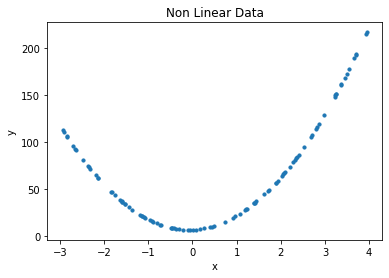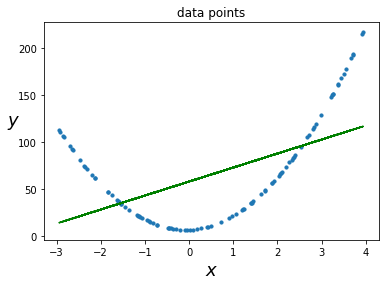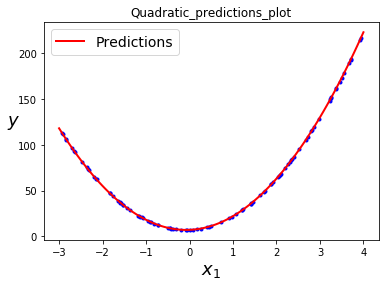Polynomial Regression for Non-Linear Data – ML
Last Updated : 03 Jun, 2020
Non-linear data is usually encountered in daily life. Consider some of the equations of motion as studied in physics.
- Projectile Motion: The height of a projectile is calculated as h = -½ gt2 +ut +ho
- Equation of motion under free fall: The distance travelled by an object after falling freely under gravity for ‘t’ seconds is ½ g t2.
- Distance travelled by a uniformly accelerated body: The distance can be calculated as ut + ½at2
where, g = acceleration due to gravity
u = initial velocity
ho = initial height
a = acceleration
In addition to these examples, Non-linear trends are also observed in the growth rate of tissues, the progress of disease epidemic, black body radiation, the motion of the pendulum etc. These examples clearly indicate that we cannot always have a linear relationship between the independent and dependent attributes. Hence, linear regression is a poor choice for dealing with such nonlinear situations. This is where Polynomial Regression comes to our rescue!!
Polynomial Regression is a powerful technique to encounter the situations where a quadratic, cubic or a higher degree nonlinear relationship exists. The underlying concept in polynomial regression is to add powers of each independent attribute as new attributes and then train a linear model on this expanded collection of features.
Let us illustrate the use of Polynomial Regression with an example. Consider a situation where the dependent variable y varies with respect to an independent variable x following a relation
y = 13x2 + 2x + 7
.
We shall use Scikit-Learn’s PolynomialFeatures class for the implementation.
Step1: Import the libraries and generate a random dataset.
import numpy as np
import matplotlib.pyplot as plt
from sklearn.linear_model import LinearRegression
from sklearn.preprocessing import PolynomialFeatures
from sklearn.metrics import mean_squared_error, r2_score
x = np.array(7 * np.random.rand(100, 1) - 3)
x1 = x.reshape(-1, 1)
y = 13 * x*x + 2 * x + 7
|
Step2: Plot the data points.
plt.scatter(x, y, s = 10)
plt.xlabel('x')
plt.ylabel('y')
plt.title('Non Linear Data')
|

Step3: First try to fit the data with a linear model.
regression_model = LinearRegression()
regression_model.fit(x1, y)
print('Slope of the line is', regression_model.coef_)
print('Intercept value is', regression_model.intercept_)
y_predicted = regression_model.predict(x1)
|
Output:
Slope of the line is [[14.87780012]] Intercept value is [58.31165769]
Step 4: Plot the data points and the linear line.
plt.scatter(x, y, s = 10)
plt.xlabel("$x$", fontsize = 18)
plt.ylabel("$y$", rotation = 0, fontsize = 18)
plt.title("data points")
plt.plot(x, y_predicted, color ='g')
|
Output:

Equation of the linear model is y = 14.87x + 58.31
Step 5: Calculate the performance of the model in terms of mean square error, root mean square error and r2 score.
mse = mean_squared_error(y, y_predicted)
rmse = np.sqrt(mean_squared_error(y, y_predicted))
r2 = r2_score(y, y_predicted)
print('MSE of Linear model', mse)
print('R2 score of Linear model: ', r2)
|
Output:
MSE of Linear model 2144.8229656677095 R2 score of Linear model: 0.3019970606151057
The performance of the linear model is not satisfactory. Let’s try Polynomial Regression with degree 2
Step 6: For improving the performance, we need to make the model a bit complex. So, lets fit a polynomial of degree 2 and proceed with linear regression.
poly_features = PolynomialFeatures(degree = 2, include_bias = False)
x_poly = poly_features.fit_transform(x1)
x[3]
|
Output:
Out[]:array([-2.84314447])
Output:
Out[]:array([-2.84314447, 8.08347046])
In addition to column x, one more column has been introduced which is the square of actual data. Now we proceed with simple Linear Regression
lin_reg = LinearRegression()
lin_reg.fit(x_poly, y)
print('Coefficients of x are', lin_reg.coef_)
print('Intercept is', lin_reg.intercept_)
|
Output:
Coefficients of x are [[ 2. 13.]] Intercept is [7.]
This is the desired equation 13x2 + 2x + 7
Step 7: Plot the quadratic equation obtained.
x_new = np.linspace(-3, 4, 100).reshape(100, 1)
x_new_poly = poly_features.transform(x_new)
y_new = lin_reg.predict(x_new_poly)
plt.plot(x, y, "b.")
plt.plot(x_new, y_new, "r-", linewidth = 2, label ="Predictions")
plt.xlabel("$x_1$", fontsize = 18)
plt.ylabel("$y$", rotation = 0, fontsize = 18)
plt.legend(loc ="upper left", fontsize = 14)
plt.title("Quadratic_predictions_plot")
plt.show()
|
Output:
Step 8: Calculate the performance of the model obtained by Polynomial Regression.
y_deg2 = lin_reg.predict(x_poly)
mse_deg2 = mean_squared_error(y, y_deg2)
r2_deg2 = r2_score(y, y_deg2)
print('MSE of Polyregression model', mse_deg2)
print('R2 score of Linear model: ', r2_deg2)
|
Output:
MSE of Polyregression model 7.668437973562934e-28 R2 score of Linear model: 1.0
The performance of polynomial regression model is far better than linear regression model for the given quadratic equation.
Important Facts: PolynomialFeatures (degree = d) transforms an array containing n features into an array containing (n + d)! / d! n! features.
Conclusion: Polynomial Regression is an effective way to deal with nonlinear data as it can find relationships between features which plain Linear Regression model struggles to do.
Similar Reads
Polynomial Regression vs Neural Network
In this article, we are going to compare polynomial regression and neural networks. What is Polynomial Regression?Polynomial regression is a technique used to model the relationship between a dependent variable (what you're trying to predict) and an independent variable (what you're basing your pred
4 min read
Dataset for Linear Regression
Linear regression is a machine learning technique used for predicting continuous outcome variable based on one or more input variables. It assumes a linear relationship between the input variables and the target variable which make it simple and easy for beginners. In this article, we will see some
6 min read
Normal Equation in Linear Regression
Linear regression is a popular method for understanding how different factors (independent variables) affect an outcome (dependent variable. At its core, linear regression aims to find the best-fitting line that minimizes the error between observed data points and predicted values. One efficient met
8 min read
Implementation of Polynomial Regression
Polynomial Regression is a form of linear regression in which the relationship between the independent variable x and dependent variable y is modelled as an nth-degree polynomial. Polynomial regression fits a nonlinear relationship between the value of x and the corresponding conditional mean of y,
9 min read
Logistic Regression With Polynomial Features
Logistic regression with polynomial features is a technique used to model complex, non-linear relationships between input variables and the target variable. This approach involves transforming the original input features into higher-degree polynomial features, which can help capture intricate patter
5 min read
Non-Linear Regression in R
Non-Linear Regression is a statistical method that is used to model the relationship between a dependent variable and one of the independent variable(s). In non-linear regression, the relationship is modeled using a non-linear equation. This means that the model can capture more complex and non-line
6 min read
Multiple Linear Regression Model with Normal Equation
Prerequisite: NumPy Consider a data set, area (x1)rooms (x2)age (x3)price (y)2338656215274569244968972954756231768234253107485 let us consider, Here area, rooms, age are features / independent variables and price is the target / dependent variable. As we know the hypothesis for multiple linear regre
3 min read
Linear vs. Polynomial Regression: Understanding the Differences
Regression analysis is a cornerstone technique in data science and machine learning, used to model the relationship between a dependent variable and one or more independent variables. Among the various types of regression, Linear Regression and Polynomial Regression are two fundamental approaches. T
6 min read
Mathematical explanation for Linear Regression working
Suppose we are given a dataset: Given is a Work vs Experience dataset of a company and the task is to predict the salary of a employee based on his / her work experience. This article aims to explain how in reality Linear regression mathematically works when we use a pre-defined function to perform
1 min read
Assumptions of Linear Regression
Linear regression is the simplest machine learning algorithm of predictive analysis. It is widely used for predicting a continuous target variable based on one or more predictor variables. While linear regression is powerful and interpretable, its validity relies heavily on certain assumptions about
7 min read